Bulletin – April 2003 Banking Fees in Australia
- Download 64KB
Introduction
Since 1997, the Reserve Bank has undertaken an annual survey of fees earned by banks' Australian operations.[1] The 2002 survey covered 19 institutions accounting for over 90 per cent of the total assets of the banking sector in Australia. The main findings are that:
- growth in fee income from deposits, loans and transaction services was 10 per cent, the smallest rise since 1997. This growth rate was a little below that in banks' domestic assets;
- the major contributors to growth in fee income have been the rapid growth in housing finance and spending on credit cards; and
- it remains the case that the increase in banks' fee income has offset only a small part of the reduction in banks' interest rate margins over the past decade.
Fees from Banking Activities
Banks' fee income from deposits, loans and transaction services amounted to $7.8 billion in 2002, up about 10 per cent on the previous year. Fee income measured as a proportion of banks' balance sheet assets declined marginally (Graph 1). As has been the case for most years since 1997, fees paid by households increased at a faster pace than those paid by businesses. In aggregate though, fees paid by businesses remain around double those paid by the household sector (Table 1).
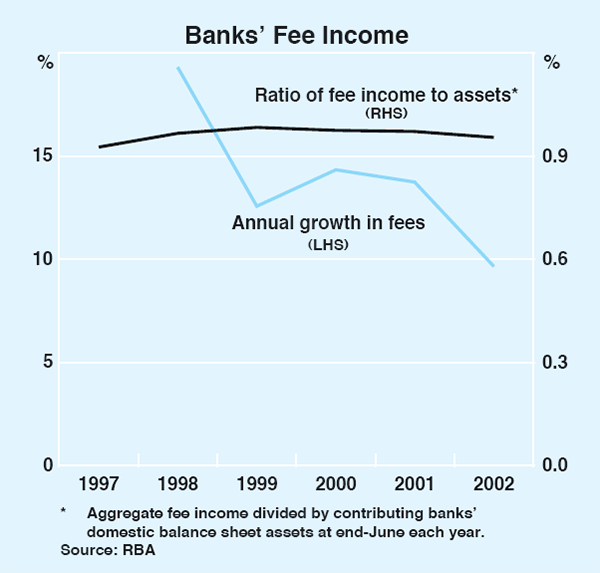
| Households | Business | Total | ||||||||
|---|---|---|---|---|---|---|---|---|---|---|
| $ million | Annual change (per cent) |
Share of total (per cent) |
$ million | Annual change (per cent) |
Share of total (per cent) |
$ million | Annual change (per cent) |
|||
| 1997 | 1,212 | na | 30 | 2,861 | na | 70 | 4,073 | na | ||
| 1998 | 1,617 | 33 | 33 | 3,242 | 13 | 67 | 4,859 | 19 | ||
| 1999 | 1,810 | 12 | 33 | 3,661 | 13 | 67 | 5,470 | 13 | ||
| 2000 | 2,148 | 19 | 34 | 4,107 | 12 | 66 | 6,255 | 14 | ||
| 2001 | 2,314 | 8 | 33 | 4,801 | 17 | 67 | 7,115 | 14 | ||
| 2002 | 2,699 | 17 | 35 | 5,104 | 6 | 65 | 7,802 | 10 | ||
|
Source: RBA |
||||||||||
Households
Fee income from providing banking services to households rose by 17 per cent in 2002, to $2.7 billion. Around one-third of this income was earned on housing and personal loans and a further third on deposit accounts. The remainder is accounted for by fees on credit cards and a range of miscellaneous fees.
The growth in banking fee income earned from households was about double the rate in the previous year, though about the same as in the couple of years before that. Loan fees grew substantially faster than those on deposits. Fee income from housing and personal loans and credit cards all showed strong rises (Table 2 and Graph 2). The main factor driving this was the increased volume of loans and number of credit card transactions, though there were some rises in the charges applied by some banks for overdrawings and late payments, and in annual fees on credit cards.
| 2000 | 2001 | 2002 | Average per cent change 1997–2002 |
Per cent change in 2002 |
|
|---|---|---|---|---|---|
| Deposits | 786 | 868 | 943 | 23 | 9 |
| Loans | 1,035 | 1,110 | 1,397 | 19 | 26 |
| – Housing | 508 | 473 | 563 | 16 | 19 |
| – Personal | 226 | 297 | 395 | 23 | 33 |
| – Credit card | 301 | 339 | 440 | 25 | 30 |
| Other fees | 327 | 336 | 358 | 6 | 7 |
| Total | 2,148 | 2,314 | 2,699 | 18 | 17 |
|
Source: RBA |
|||||
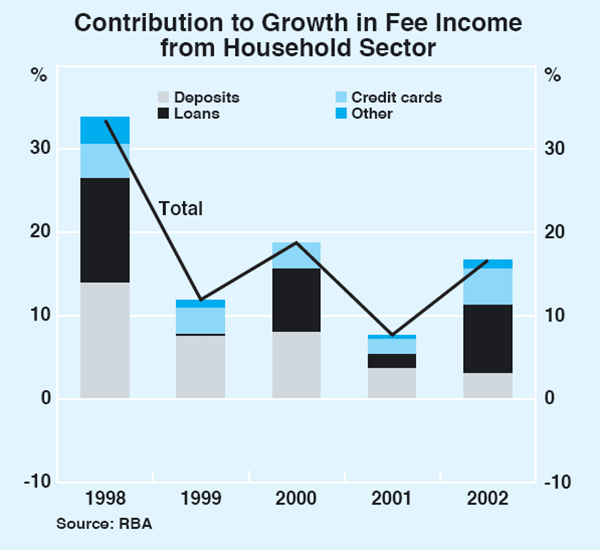
Fee income from household deposit accounts increased by 9 per cent. Deposit balances grew by around 13 per cent, and as a result the ratio of total fee income to deposits declined for the second consecutive year. As has been the case for a number of years, fee income from account-servicing charges grew more slowly than fees from transactions activity. This is despite a significant increase in average monthly account-servicing fees, in some cases in exchange for fee-free transactions. Some banks introduced the revised fee structures part way through the financial year so the full effect may be yet to show up.
Average fees charged by the major banks for transactions above the monthly fee-free limit have generally remained unchanged over the past year (Table 3). Average fees for over-the-counter transactions fell, but this was in part offset by an increase in cheque processing fees. Fees on electronic transactions remain substantially below those on paper-based transactions. The difference has, however, narrowed over recent years as electronic banking has become established and introductory discounts have been wound back. Nevertheless, data from the four largest banks suggest the average fee levied across all electronic transactions is less than half that on a paper-based transaction and there has been a marked shift by customers towards the former. The increased use of electronic payment channels, particularly the internet, has been most pronounced in the younger age groups (Graph 3).
| 1995 | 1998 | 1999 | 2000 | 2001 | 2002 | |
|---|---|---|---|---|---|---|
| Account-servicing (per month)(b) | 2.00 | 3.50 | 3.75 | 3.75 | 3.75 | 5.25 |
| Fees per excess transaction(c) | ||||||
| – Counter withdrawals | 1.00 | 2.00 | 2.15 | 2.15 | 2.75 | 2.50 |
| – Cheques | 0.70 | 0.65 | 0.75 | 0.75 | 0.90 | 1.00 |
| – Own bank's ATM | 0.40 | 0.55 | 0.60 | 0.60 | 0.65 | 0.60 |
| – Other bank's ATM | 0.40 | 1.05 | 1.30 | 1.40 | 1.40 | 1.40 |
| – EFTPOS | 0.40 | 0.45 | 0.50 | 0.50 | 0.50 | 0.45 |
| – Telephone | na | 0.30 | 0.35 | 0.35 | 0.45 | 0.45 |
| – Internet | na | 0.20 | 0.30 | 0.30 | 0.25 | 0.25 |
|
(a) Average for four largest banks. Based on public information on selected,
widely-used accounts. As at June of each year. Sources: Cannex; RBA |
||||||
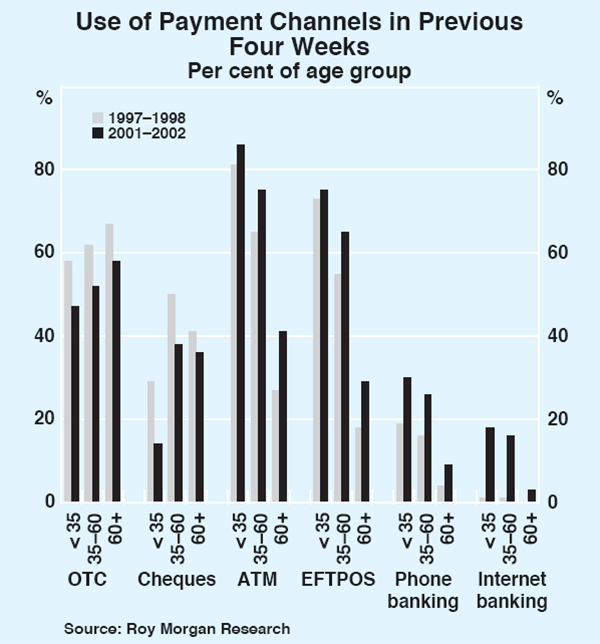
At the level of the individual, the amount paid in bank fees depends on a range of factors, including the type of account held, how often the account is used, the balance in the account, and the payment methods used. Most banks waive or reduce account-servicing fees and transaction fees for students, people with a disability, pensioners and customers in rural locations who are unable to access ATM facilities. Similarly, a range of fees is typically waived if the customer has a ‘significant’ relationship with the bank. Overall, individuals that maintain high balances and make few transactions can avoid many of the fees introduced since the mid 1990s. In contrast, customers with low balances who make frequent transactions using non-electronic channels are paying considerably more in fees than was the case in the mid 1990s.
Businesses
In 2002, businesses paid banking fees of $5.1 billion, up 6 per cent on the previous year, the smallest increase since the commencement of the survey (Graph 4 and Table 4). The fastest growing component, as has been the case for a number of years, was merchant-service fees associated with credit and debit card transactions. These fees were up broadly in line with overall spending on credit and debit cards and now account for almost one-third of fees paid by the business sector.
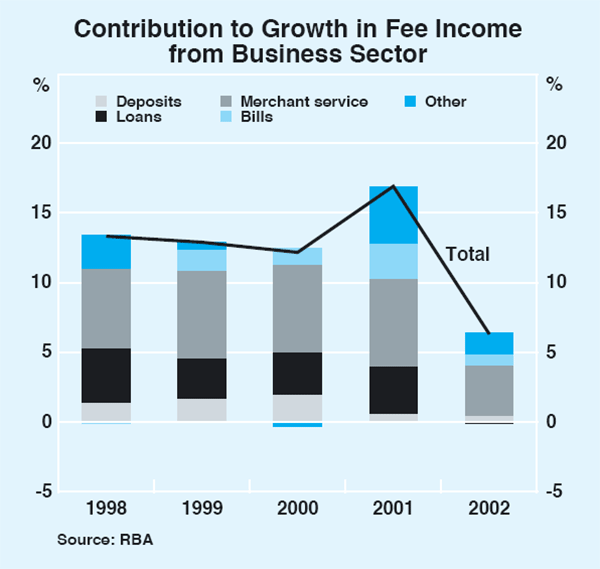
| 2000 | 2001 | 2002 | Average per cent change 1997–2002 |
Per cent change in 2002 |
|
|---|---|---|---|---|---|
| Small business | 1,187 | 1,337 | 1,360 | 7 | 2 |
| – Deposits | 274 | 292 | 323 | 15 | 11 |
| – Loans | 633 | 708 | 679 | 6 | −4 |
| – Bills | 281 | 337 | 358 | 5 | 6 |
| Large business | 1,290 | 1,409 | 1,439 | 9 | 2 |
| – Deposits | 112 | 122 | 112 | 21 | −8 |
| – Loans | 552 | 615 | 638 | 13 | 4 |
| – Bills | 626 | 673 | 689 | 6 | 2 |
| Merchant-service fees | 1,163 | 1,421 | 1,597 | 22 | 12 |
| Other fees | 466 | 634 | 708 | 13 | 12 |
| Total | 4,107 | 4,801 | 5,104 | 12 | 6 |
|
Source: RBA |
|||||
Fee income from loan accounts and bill facilities rose by only 1 per cent in total; within that fee income from loans to small businesses declined by 4 per cent. The ratio of loan and bill fees to business credit outstanding fell slightly in 2002, to 0.95 per cent.
Fee income earned from deposit accounts grew more quickly than those on loan accounts, up 5 per cent over the year. Within the total, account-servicing fee income fell while that on transactions rose quite sharply. The rise in the latter reflects, in part, an increase in unit costs, with fees for cheque, telephone and internet transactions all rising in 2002 (Table 5). In aggregate, banks earn significantly more in account-servicing and transaction fees on deposit accounts operated by small businesses than they do on deposit accounts operated by large businesses. This is partly because of the much larger number of small business accounts.
| 1995 | 1998 | 1999 | 2000 | 2001 | 2002 | |
|---|---|---|---|---|---|---|
| Account-servicing (per quarter) | 33 | 30 | 30 | 30 | 31 | 35 |
| Fees per excess transaction | ||||||
| – Cheque withdrawal | 0.25 | 0.40 | 0.40 | 0.40 | 0.45 | 0.50 |
| – Telephone transactions | .. | 0.35 | 0.25 | 0.20 | 0.15 | 0.20 |
| – Internet transactions | .. | 0.25 | 0.20 | 0.15 | 0.15 | 0.20 |
| Periodic pay deduction | ||||||
| – Own bank | 1.30 | 1.15 | 1.65 | 1.65 | 1.65 | 1.85 |
| – Other bank | 2.20 | 2.95 | 2.95 | 2.95 | 3.20 | 4.65 |
| Memo item: | ||||||
| Number of free transactions (per quarter) | 92 | 114 | 114 | 105 | 105 | 98 |
|
(a) Average for four largest banks. Based on public information on selected, widely used accounts. As at June of each year. Source: Cannex |
||||||
Relativity between Fees and Interest Margins
One question that has been of interest over recent years is whether the increase in fees has offset the benefits to bank customers from the reductions in banks' interest margins that have occurred over the past decade. The Reserve Bank's analysis of this in past years has concluded that the increase in fees has offset only a small part of the effect of the reduction in margins. The latest data do not change this conclusion.
Over the past decade, the spread between the average interest rate received by banks and the average interest rate paid has fallen from 4 percentage points to around 2¾ percentage points (Graph 5). The fall in the margin between rates for residential mortgages in Australia and short-term money-market rates has been even more pronounced, with a decline from over 4 percentage points to around 1¾ percentage points.
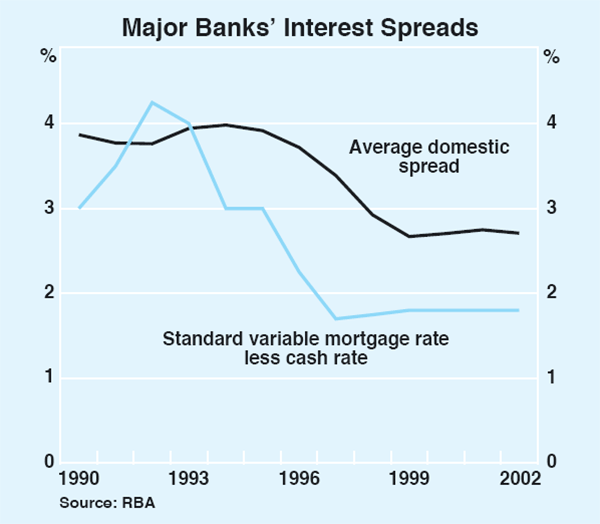
The reduction in interest rate margins and the increase in fee income can be compared by expressing fees as a percentage of total loans or deposits. Fees on household loans, expressed as a percentage of household credit, have been almost unchanged since 1997. For businesses, loan fees have fallen relative to total loans outstanding, from 1.1 per cent to 0.95 per cent. On the other hand, merchant-service fees, driven by growing prevalence of credit and debit cards, have increased from 0.15 per cent to 0.20 per cent of banks' assets. Total fee income earned from deposit accounts has grown more quickly than total deposits, lifting the ratio of fees to deposits from around 0.25 to 0.35 per cent. In aggregate, fee income of banks, as a percentage of assets, has been fairly stable over the past five years.
Graph 6 shows the sum of the major banks' net interest income and fee income, as a percentage of bank assets. This percentage has fallen from 4 per cent in 1997 to 3 per cent in 2002, confirming that the reduction in interest margins has been larger than the increase in fee income.
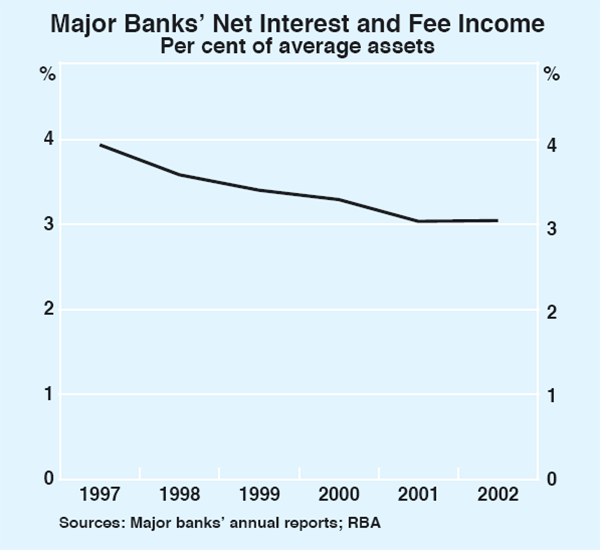
As noted earlier, bank customers have not been affected uniformly by these trends in fees and interest margins. Arguably, those who have benefited most are those with a loan secured by a residential mortgage, who use electronic payments channels and who avoid late payment and other similar charges. Such customers have benefited from lower interest rate margins and can avoid many of the banking fees introduced over the past decade. In contrast, those customers without a loan, who have low balances and have a high volume of transactions would not have benefited from the fall in interest margins and would be paying higher fees.
Footnote
The main focus of the survey is fee income earned in the process of taking deposits, making loans and providing payment services. In the past, other forms of non-interest income were also covered, but differences in the way in which banking groups report income from funds management, insurance and other activities have lessened the usefulness of these data. As such, the data on non-banking fees have been discontinued. [1]